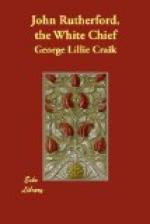Whatever Rutherford’s object may have been, and whether he deceived the author and publisher of “The New Zealanders,” or merely erred through ignorance and lack of observation, there is no doubt that he spent some years with the Maoris in the northern part of New Zealand. His tattooed face is sufficient evidence of that. The pattern is the Maori “moko.” The tattooing on his breast, stomach, and arms, however, is not the work of Maoris; that was done, probably, by natives at some of the islands, or by sailors. I hardly think that those who read the narrative will agree with Bishop Williams’s opinion that it is “a mere romance.” It is more like the story of an ignorant, unobservant, careless sailor, who entertained no idea that any importance would be attached to his statements. Many mistakes were probably made in the work of dictating the narrative to a fellow-sailor. If Rutherford had been bent upon making a romantic story, he would have told it in a different form. There is no straining after effect in the manuscript reproduced by Craik. The faults are inaccuracies, not exaggerations. Some excuse may be found for Rutherford’s mistakes in the description of the battle Te Ika-a-rangi-nui in the fact that modern Maori scholars cannot agree on important details, there being differences of opinion in regard to even the year in which the battle was fought.
[Illustration: A Maori’s shoulder mat Christchurch Museum.]
It is felt that, with all its blemishes, the story has a good claim to be included in the list of New Zealand works that are now being reprinted by Messrs. Whitcombe and Tombs, to whom the people of New Zealand are deeply indebted. When Mr. Whitcombe first asked me to edit Rutherford’s story for his firm, I proposed to take it alone, leaving out all the rest of Craik’s work in “The New Zealanders.” On reading the book again I came to the conclusion that many of Craik’s remarks, although discursive at times, are sufficiently interesting to be read now, and I have included in the reprint a large portion of his original writings. I have retained his spelling of Maori words, but have made many corrections in footnotes. The book is not sent out as an authentic account of the Maoris. “The New Zealanders” was the first book that attempted to deal with them, and it has been superseded by many which have been written in the light of more extensive knowledge, and in them students will find results of much patient study and research.
James Drummond.
Christchurch,
February 13th, 1908.
FOOTNOTES:
[Footnote A: At my request, Mr. S. Percy Smith, the author of “Hawaiki, the Original Home of the Maori,” endeavoured to trace “Aimy,” but even his extensive knowledge of the Maori language and tribal histories failed to bring that man to light. Mr. Smith explains that “Ai” in Rutherford’s spelling represents “E,” a vocative, in the accepted method of spelling, and “my” represents “mai.” The two words, combined, would be “E Mai.” In this way, “Mai’s” attention would be called. But “Mai” may be the first, second, or third syllable of a man’s name, according to euphony. The name supplied in the narrative, therefore, is no guide in a search for Rutherford’s friendly chief.]




